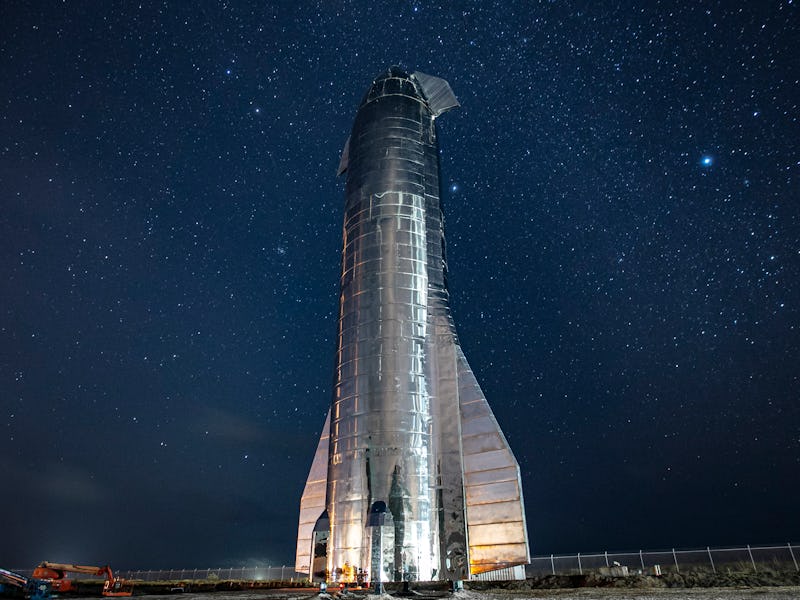SpaceX’s Starship could transform humanity's interactions with space
It could become a lot easier to send things into space.

Starship, SpaceX’s ambitious rocket under development, could have an underestimated effect on society’s interactions with space.
The stainless steel rocket is currently in the prototyping phase, but when complete it’s set to unlock some of SpaceX’s most ambitious targets. It offers a fully-reusable design, which could drop launch prices lower than ever to $20,000 per ton. It uses easier-to-harvest rocket fuel, which could create a planet-hopping network to the moon, Mars and beyond. It can also carry over 100 tons or 100 people into orbit at once, meaning humans can send more into space than ever before.
All this adds up to a rocket that could smash current annual launch metrics, CEO Elon Musk explained via Twitter Thursday. Humanity currently sends around 500 tons into space per year. Around half of this is completed by SpaceX’s Falcon family of rockets, which covers the Falcon 9 and Falcon Heavy. But the Starship is designed to fly three times per day, or 1,000 times per year.
Assuming SpaceX builds around 100 Starships, matching the number of Falcon rockets, that amounts to a potential capacity of 10 million tons of payload entering space per year. That’s 20,000 times more payload than the whole planet is sending to space annually right now.
That’s a lot of stuff — and it could eventually pave the way for Musk’s big ambition to build a city on Mars.
The Starship taking off.
SpaceX Starship: why would you want to send up so much stuff?
Expanding humanity’s ability to send stuff into space could offer new opportunities for the future.
Astronauts on the International Space Station are already regularly sending cargo into space to complete scientific studies. Recent experiments include the first lab-grown burger grown in microgravity, a biofabrication facility that could help create organ-like tissues, and slime to create educational videos for Nickelodeon.
SpaceX has its own ideas for how it wants to use the added capacity. It plans to develop the Starlink, an internet connectivity constellation that could eventually number 42,000 satellites. Considering the total number of satellites in space is somewhere around 5,000 it could vastly increase the number of crafts in orbit. Using so many satellites at low altitude could enable faster response times and higher speeds, while enabling SpaceX to earn more money through offering internet connection services.
The company isn’t limiting its satellite ambitions to its own endeavors, though. Starship’s first mission is expected to send a telecommunications satellite into space as early as 2021. Jonathan Hofeller, SpaceX vice president of commercial sales, said in July 2019 that the company will encourage others to get creative with Starship’s capabilities: “You could potentially recapture a satellite and bring it down if you wanted to. It’s very similar to the [space] shuttle bay in that regard. So we have this tool, and we are challenging the industry: what would you do with it?”
Humans could even track all this extra stuff in space with even more satellites. MIT Technology Review explained in September how NorthStar wants to send up 40 satellites to track space debris. This would help scientists better measure what’s actually floating around up there, avoiding the distortion that comes with measurements through the atmosphere.
Beyond the scientific applications, this could result in a rush to a newly-expanding market. A June 2018 panel session at the Space Frontier Foundation’s NewSpace conference discussed how the industry, valued at around $350 billion, could be worth over $1 trillion in the 2040s.
A Mars city.
SpaceX Starship: the ship that could build a city on Mars
Perhaps SpaceX’s most ambitious goal is to build a city on Mars. This could be enabled by a fleet of Starships, all lifting cargo to the planet.
Musk explained that around 1,000 Starships would be necessary to start a city. The fleet would transport around one million tons of cargo to the planet, which Musk estimates would be enough to develop a self-sustaining city. That would take around 20 years, as the Earth and Mars align around once every two years.
SpaceX has big plans to meet these lofty goals. It’s aiming to build one new Raptor engine every day next year, with each Starship vessel and Super Heavy booster using around 40 engines total. It’s aiming to build new Starship prototypes at both its Texas and Florida facilities.
All of this is in service of a ship that could transport 100 humans into space at a time. Space industry venture capitalist Rick Tumlinson previously told Inverse that this could be a major step in humanity’s history.
“Even if he doesn’t go to Mars or the moon, the ability to deliver 100-plus people at a time to orbit, to space itself, is going to be the beginning of the biggest revolution in the history of humanity, if not life itself,” Tumlinson said in February 2019. “Having the ability to climb out of the gravity well of Earth means we have the potential to make life and humanity immortal, unkillable.”
That doesn’t mean hopping on the Starship would necessarily be an enticing prospect. Musk himself was keen to stress that the first humans to make the several-month journey to Mars will be in for a rough ride.
“In the beginning, assuming you even make it there alive, Mars will be far more dangerous & difficult than Earth & take decades of hard labor to make self-sufficient,” Musk wrote on Thursday. “That’s the sales pitch. Want to go?”